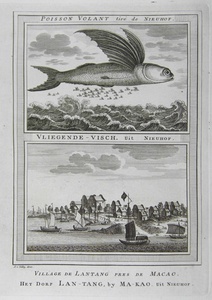| Method | Copper engraving |
| Artist | Jakob van der Schley |
| Published | [A la Haye, Chez Pierre de Hondt, MDCCXLIX. Avec Privilege de Sa Majeste Imperiale, & de Nos Seigneurs les Etats de Hollande & de West-Frise. 1749] |
| Dimensions | Image 186 x 135 mm, Plate 214 x 183 mm, Sheet 277 x 210 mm |
| Notes |
A depiction of a Chinese flying fish and a view of a fishing village near Macao, from the Dutch edition of the Description de la Chine, part of Prévost's monumental 'l'Histoire Géneral des Voyages.' The plate depicts two separate subjects. At the top is an illustration of a flying fish, with a shoal of similar fish in the distance behind. Occuring only in tropical and sub-tropical waters, flying fish were a particularly spectacular sight for most European travellers in China. Below is a scene of a small fishing village, identified as a certain 'Lantang,' on the Pearl River Delta near to Macau. The small collection of high-roofed houses stand on the shoreline, where a number of Chinese vessels are moored. Both views are based upon descriptions by Nieuhof. The Histoire Géneral des Voyages was a monumental eighteenth century general history divided according to geographic region. The original volumes were written by Antoine François Prévost d'Exiles, a French author, novelist, theologian, natural historian, and a priest of the Jesuit and Benedictine orders, but continued by numerous other authors after Prévost's death. The earliest books mostly deal with the Far East and South-East Asia, providing a general history of their regions, kingdoms, customs, culture, costumes, natural phenomena and religious beliefs. Much of Prévost's information is derived from the reports of Jesuit missionaries, Portuguese merchants, and famous explorers, from Marco Polo to Sir Francis Drake. Although written in French, the popularity of the Histoire among Dutch audiences meant that many of the illustrative plates and maps published to accompany the work were either re-engraved or subtitled in Dutch by the engraver Jakob van der Schley. Prévost himself had travelled widely throughout the Netherlands, launching his literary career in Amsterdam and the Hague after fleeing the Benedictines in France. Prevost's work on China, and indeed many of van der Schley's plates, owe a great debt to Johan Nieuhoff (1618-1672) , a Dutch traveller who explored much of China, India, and Brazil while in the employ of the Dutch East India Company. Nieuhoff wrote extensively, with a particular focus on China, for his memoirs, and his numerous drawings of Chinese places and people were much copied by later engravers for numerous works of Chinese interest. Nieuhoff's own book became a major source of inspiration for eighteenth century chinoiserie, and are amongst the first western illustrations to depict the Chinese people in a manner which was based upon personal observation rather than the tradition of oriental fantasy. Jakob van der Schley (26th July 1715 - 12th February 1779), also known as Jan von Schley or Jacobus van Schley, was a Dutch engraver and draughtsman. An apprentice of the French engraver Bernard Picart, he is best known for his engravings of the majority of plates in the Dutch edition of 'l'Histoire Géneral des Voyages.' Despite producing mainly maps and views for this work, van der Schley was predominantly a portrait artist and literary illustrator. Condition: Minor staining and creasing to bottom edge of sheet, not affecting image. Sheet trimmed within plate on left margin, as issued. Binders crease and holes to left margin. Otherwise a clean, crisp impression with partial crown watermark. |
| Framing | unmounted |
| Price | £40.00 |
| Stock ID | 40819 |

